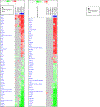Inferred inactivation of the Cftr gene in the duodena of mice exposed to hexavalent chromium (Cr(VI)) in drinking water supports its tumor-suppressor status and implies its potential role in Cr(VI)-induced carcinogenesis of the small intestines
- PMID: 34688701
- PMCID: PMC9659473
- DOI: 10.1016/j.taap.2021.115773
Inferred inactivation of the Cftr gene in the duodena of mice exposed to hexavalent chromium (Cr(VI)) in drinking water supports its tumor-suppressor status and implies its potential role in Cr(VI)-induced carcinogenesis of the small intestines
Abstract
Carcinogenicity of hexavalent chromium [Cr (VI)] has been supported by a number of epidemiological and animal studies; however, its carcinogenic mode of action is still incompletely understood. To identify mechanisms involved in cancer development, we analyzed gene expression data from duodena of mice exposed to Cr(VI) in drinking water. This analysis included (i) identification of upstream regulatory molecules that are likely responsible for the observed gene expression changes, (ii) identification of annotated gene expression data from public repositories that correlate with gene expression changes in duodena of Cr(VI)-exposed mice, and (iii) identification of hallmark and oncogenic signature gene sets relevant to these data. We identified the inactivated CFTR gene among the top scoring upstream regulators, and found positive correlations between the expression data from duodena of Cr(VI)-exposed mice and other datasets in public repositories associated with the inactivation of the CFTR gene. In addition, we found enrichment of signatures for oncogenic signaling, sustained cell proliferation, impaired apoptosis and tissue remodeling. Results of our computational study support the tumor-suppressor role of the CFTR gene. Furthermore, our results support human relevance of the Cr(VI)-mediated carcinogenesis observed in the small intestines of exposed mice and suggest possible groups that may be more vulnerable to the adverse outcomes associated with the inactivation of CFTR by hexavalent chromium or other agents. Lastly, our findings predict, for the first time, the role of CFTR inactivation in chemical carcinogenesis and expand the range of plausible mechanisms that may be operative in Cr(VI)-mediated carcinogenesis of intestinal and possibly other tissues.
Keywords: CFTR; Carcinogenesis; Chromium; Duodenal cancer; Toxicogenomics.
Published by Elsevier Inc.
Figures







Similar articles
-
Synchrotron-based imaging of chromium and γ-H2AX immunostaining in the duodenum following repeated exposure to Cr(VI) in drinking water.Toxicol Sci. 2015 Jan;143(1):16-25. doi: 10.1093/toxsci/kfu206. Epub 2014 Oct 28. Toxicol Sci. 2015. PMID: 25352572 Free PMC article.
-
Comparison of in vivo genotoxic and carcinogenic potency to augment mode of action analysis: Case study with hexavalent chromium.Mutat Res Genet Toxicol Environ Mutagen. 2016 Apr;800-801:28-34. doi: 10.1016/j.mrgentox.2016.01.008. Epub 2016 Mar 6. Mutat Res Genet Toxicol Environ Mutagen. 2016. PMID: 27085472
-
Assessment of the mutagenic potential of hexavalent chromium in the duodenum of big blue® rats.Toxicol Appl Pharmacol. 2017 Sep 1;330:48-52. doi: 10.1016/j.taap.2017.07.002. Epub 2017 Jul 5. Toxicol Appl Pharmacol. 2017. PMID: 28687238
-
Is hexavalent chromium carcinogenic via ingestion? A weight-of-evidence review.J Toxicol Environ Health A. 2002 May 24;65(10):701-46. doi: 10.1080/00984100290071018. J Toxicol Environ Health A. 2002. PMID: 12028825 Review.
-
Chromium in drinking water: sources, metabolism, and cancer risks.Chem Res Toxicol. 2011 Oct 17;24(10):1617-29. doi: 10.1021/tx200251t. Epub 2011 Jul 28. Chem Res Toxicol. 2011. PMID: 21766833 Free PMC article. Review.
Cited by
-
Association between water source and chronic gastrointestinal diseases in Chinese: A cross-sectional and longitudinal study.Front Public Health. 2022 Nov 10;10:992462. doi: 10.3389/fpubh.2022.992462. eCollection 2022. Front Public Health. 2022. PMID: 36438297 Free PMC article.
References
-
- Shaw Environmental Inc.: Industry profile, exposure profile, technological feasibility evaluation, and environmental impact for industries affected by a proposed OSHA standard for hexavalent chromium Cincinnati, OH: OSHA, U.S. Department of Labor; 2006.
-
- International Agency for Research on Cancer: Arsenic, metals, fibres and dusts, vol. 100C. Lyon, France: IARC; 2012.
MeSH terms
Substances
Grants and funding
LinkOut - more resources
Full Text Sources
Medical

